One of the questions architects always ask themselves when confronted with adding new features to existing golf courses, writes Simon Gidman, Golf Course Architect, is how best to blend their own architectural philosophies with the design principles already established on an existing golf course?
As architects keep on saying, maintenance equipment, specifications , golfing equipment and design approaches have all changed so much over the years it is often difficult to keep up, and the principles of newly built courses are a far cry from when a majority of the courses in the UK were first built.
More often than not as architects we are dealing with old fashioned golf courses with simple, often small greens, sharp angles on the surrounds and inappropriately located bunkering. That is a given – but how does one best modify new holes without them being completely at odds with the remaining holes………or does that really matter?
After all, one of the most famous courses in the world, Augusta National has seen many changes over the years. The 10th green has been moved forward from just in front of the approach bunker to its current location, the 8th, 14th and 16th greens have all seen significant changes. Have these physical changes blended into their former surrounds or have maintenance practices slowly done the trick?
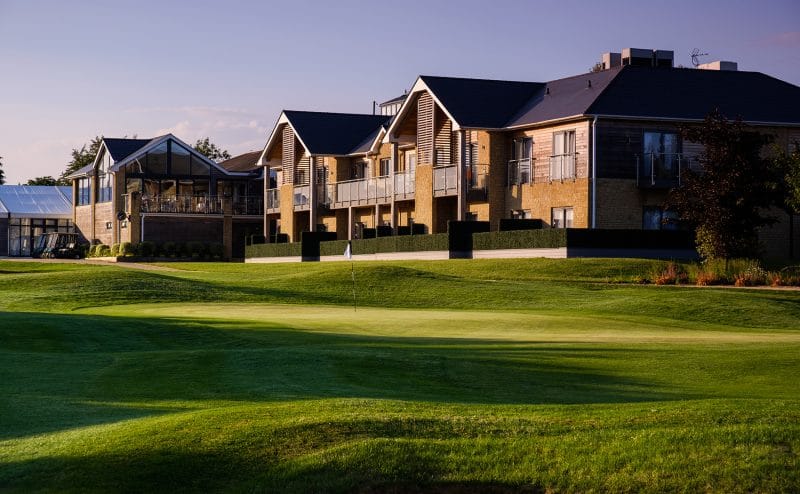
The Cotswold Club, Hotel, Spa and Golf Course
At the CHSGC the client is in the process of adding new apartments to the clubhouse area which has directly affected holes 1 and 9, and because of the consequential reduction in length the decision was made to extend an additional hole, 13, to a new green location just beyond the existing green. The principles of the revised layout were fairly straightforward and particularly with holes 1 and 13 existing features were brought into play which have improved the holes considerably.
Existing characteristics
The first nine holes at the Cotswold H & G.C. were built in the 1890s with no specific architectural designer. It is fair to say that the layout was built economically, with most of the greens built on a simple cut and fill basis, with often sharp slopes off the surrounds and in the case of (existing) hole 13, a 450 yd long par 4 played to a blind green in a hollow, barely 200 sq. m. in size.
The fact that the course has no architectural heritage is to my mind a significant issue. Had the course been designed by a Harry Colt, an Alister Mackenzie or a James Braid my approach would have been entirely different.
Many modern principles of golf course architecture were either already in use by these greats or developed by them and features such as contoured greens, hollows, mounding, swales and depressions around greens etc. were already widely used; even sharper angles and steeper slopes, which were perhaps a feature of their work, I would, frankly use again as long as it did not detract too much from the maintenance.
However, with a golf course of less architectural significance and with perhaps obvious flaws that need to be corrected, I do not see the need to be quite so conservative. After all, the primary hopes for any of the changes we make is that golfers enjoy the challenge set before them.
At the Cotswold H.S. & G.C. it was not difficult to know what to improve, just how best to do it.
On all three holes the greens needed to be made larger, more interest added to the putting surfaces, be receptive to the pitch shot, bunkered differently and of course maintainable by the greens staff
The improvements to Hole 1 were fairly straight-forward. The location of the new green could be re-sited behind the existing green, but the overhead cables had to be avoided. I wanted the golfer to be able to see the whole of the green and the new greenside bunker from the fairway, so it had to be raised. This had to be achieved without:
- a) creating too steep a slope to the right of the green
- b) limiting tree clearance in order to retain some cover between new green 1 and hole 2; and
- c) raising the green too high to avoid the green looking out of place and somewhat incongruous.
Considerations of levels and design!
The existing green could simply be approached by a half-topped shot played to the left of the approach which just ‘bobbled’ on to the putting surface – hardly challenging! The new green needed a valley in front of it, which would not only encourage a better pitch shot but also help to better frame the entire green.
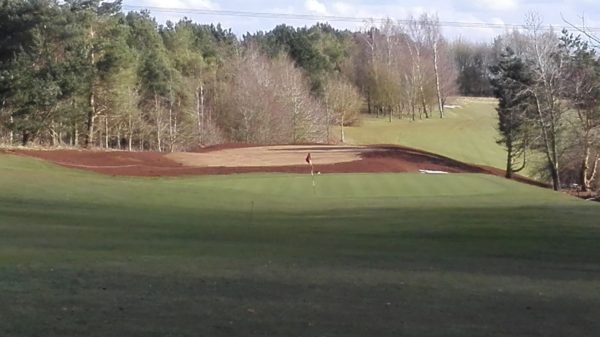
The new green is about 450 m² with about 15% of the putting surface lost to improved contouring. A quite simple green when the pin is at the front and used for more everyday play but the slopes become a little more complicated when the pin is at the back, and used during weekends or competitions.
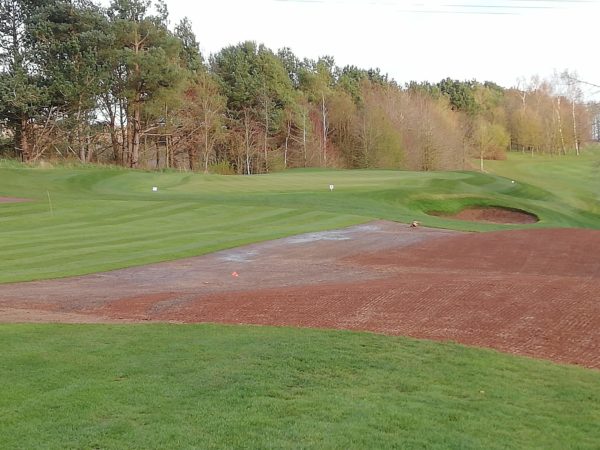
Unlike green 9 (!!) where, as the hole is only a very short par of barely 290 yds the whole green is well contoured – but not I hasten to add – excessively . There is a dip running through the centre of the green which creates a clear distinction between back and front and both levels are awkward but perfectly pinnable. There is nothing like this contouring elsewhere on the course. Does the putting surface run against other greens on the course ? Well yes it does , but so far everybody seems to have enjoyed the challenge and haven’t moaned too much about three putting! Now had this been a 400+ yard hole the approach would have been entirely different, but that is the fun of a short par 4 ( a greatly neglected golf hole !) there is so much you can do with it ,and because of its shortness always remains fair.
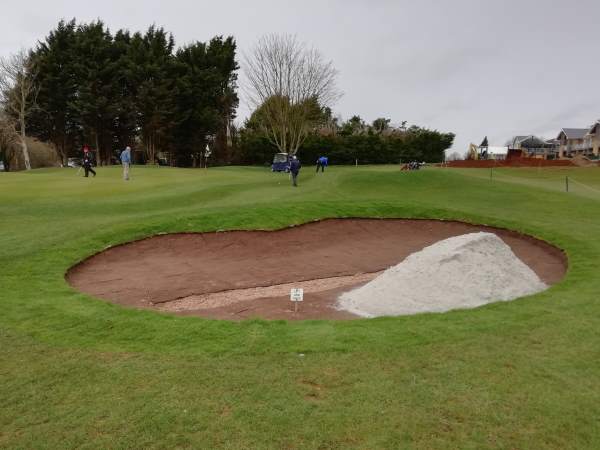
Finally to hole 13 which we extended from a difficult par 4 to a difficult par 5.When we first looked at the opportunity of extending the green forward I noticed there was a magnificent Ash tree around which the approach to the green could be designed – yet nobody seemed to realise that it was even there ! We had to remove a couple of weak hawthorns either side of the ash but as soon as we did there it was, a magnificently shaped and mature ash tree. Of course the problem with designing around trees, and one of the first things I was taught at landscape college, is that trees have a finite life span ( ash trees perhaps more than most ), but let us hope it stays there for another 100 years and continues to be the talking point of the hole. Whereas before the green for this former long and difficult par 4 was blind and very small, now it is perfectly visible along the entire fairway, and is set naturally into an upslope so was relatively easily constructed.
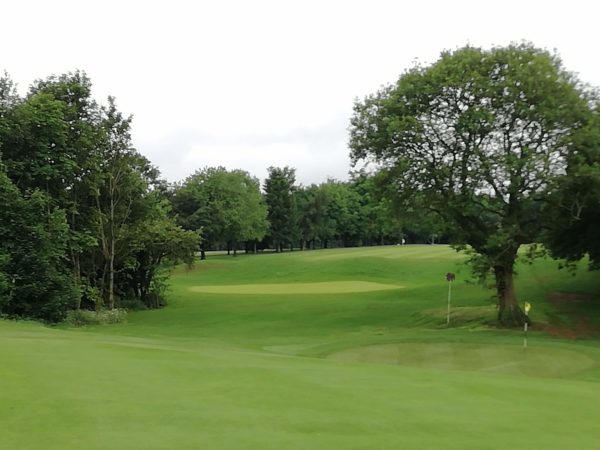
The greens were all constructed and shaped by Paul Davies at Shapewright who also carried out the drainage, rootzone spreading and seeding. It took about 6 -8 weeks to do the work in April 2018 and despite the horrendously hot summer and having to look after the other 18 greens, the staff at the golf club worked very hard to get the 9th green ready for play before the work started on the apartments ,barely 6 months after the initial construction was completed ! Holes 1 and 13 were open for play this spring.
So far I can report that the reception received for these three holes has been excellent. Yes, the shaping is not really in keeping with the remaining 15 greens, yes, the greens have more of a modern slant and they reflect better modern playing and maintenance equipment, but perhaps most important of all the members seem to like them and to enjoy the extra challenge.
The Cotswold Club, Hotel, Spa and Golf Course https://cotswoldsclub.co.uk/
Simon Gidman Golf Course Architects http://www.gidmangolf.co.uk/

